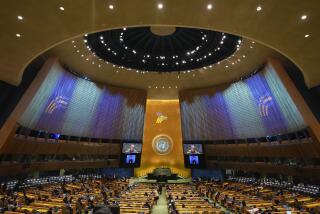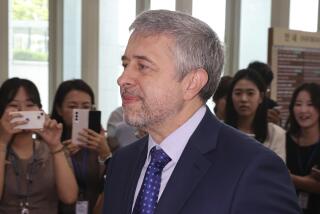Analysis: Singapore summit agreement recycles old deals, defers the hard work
Reporting from Washington — The diplomatic history of U.S.-North Korean relations is littered with broken promises to denuclearize and deals gone sour.
At their meeting in Singapore, President Trump and North Korean leader Kim Jong Un signed a document remarkably similar to, and as vague as, those that have failed in the past to bring peace to the Korean peninsula and rid it of nuclear arms.
The summit, for all the anticipatory hype, was never expected to produce much in the way of new policies or strategy. But it actually produced less than many analysts expected.
The meeting did succeed in turning down the heated rhetoric, shifting the relationship to one of diplomacy instead of threatened war and suggesting a new, tentative rapprochement between two longtime foes.
But the absence of specifics hands a gargantuan task to Secretary of State Mike Pompeo and other American negotiators who must translate what Trump described as a congenial spirit of cooperation into concrete steps.
In the months, even years, to come, Pompeo and his team -- and perhaps their successors — will have to try set out ways to begin dismantling Kim’s arsenal and the timing and verification of those actions.
The United States and North Korea have still not agreed on the very definition of denuclearization; as far as is known, Kim did not even offer a declaration of the components of his nuclear, chemical and biological arsenal, a step many experts considered to be fundamental.
“We’ve bought time, we averted confrontation, but you needed a much more robust denuclearization process,’’ said Scott Snyder, director of the U.S.-Korea policy program at the Council on Foreign Relations.
“President Trump was in full salesman mode and didn’t have that much to sell,’’ Snyder added.
Buying time is a talent the North Koreans have perfected, one that takes advantage of the fact that U.S. officials have many other priorities to occupy their attention.
For the U.S. now, “what is important is not to declare victory and go home, but to maintain the momentum,” said Joel S. Wit, a veteran negotiator on a nuclear deal with North Korea in 1994 that later collapsed. “Senior Americans have to stay involved and focused. There needs to be more than one meeting.’’
Trump, after first boasting he would strike a deal swiftly, now concedes time will be needed, saying talks with North Korea are a “process’’ even as he omitted from his agreement with Kim the standard, long-held U.S. demand for “complete, verifiable, irreversible denuclearization.”
American skepticism about North Korea is born of history. In addition to the 1994 deal that broke down, the North Koreans also pledged in 2005 to denuclearize. In 2012, shortly after ascending to the leadership of his country, Kim Jong Un agreed to a moratorium on long-range missile launches, nuclear tests and production of fissile material. Only six weeks elapsed before North Korea tried to launch an intercontinental ballistic missile.
And despite the warmth between Trump and Kim on display in Singapore, the distrust between the United States and North Korea runs long and deep. Anti-Americanism is entrenched in almost every aspect of North Korean culture from children’s songs to school textbooks that call for bayoneting U.S. soldiers.
Beyond the issue of trust, the physical process of denuclearization could take 10 to 15 years, meaning that implementing any deal — assuming that one is eventually negotiated — would require more than one administration.
Verifying that North Korea was living up to an agreement would likely require experienced nuclear inspectors and Korean-speaking scientists who can go through North Korean records to account for the fissile material the country has produced.
North Korea has produced enough plutonium to produce 30 to 60 nuclear warheads, which are most likely hidden deep in its mountainous terrain. Although North Korea’s nuclear reactor at Yongbyon is well known and clearly monitored by satellites, the U.S. does not know the location of some of the centrifuges used to produce highly enriched uranium.
“Everything has to be done in phases so that we can watch each other over a period of years,’’ Wit said.
Snyder, of the Council on Foreign Relations, said he doubted the Trump administration would ultimately have the tenacity and focus to hash out a durable deal with North Korea.
“America suffers from attention deficit disorder; we have so many issues around the world we have to take care of [and] North Korea requires resolve and persistence,” Snyder said.
Trump’s critics complain that the president has been looking for a quick political victory, not a lasting solution to the dilemma that is North Korea.
“He is so vested in success. Trump wants everything to be fast. He’ll say: ‘This is great. Where’s my Nobel Prize?’ He only needs a deal that will last through the midterm elections,’’ said Daniel Russel, an assistant secretary of State for Asian affairs in the Obama administration.
Trump touted as a concession from Kim an agreement by North Korea to help recover remains of U.S. servicemen lost in the Korean war. That, too, was a repeat of past deals.
A joint U.S.-North Korean program, funded by the United States, to recover remains took place between 1996 and 2005. Teams conducted 33 search missions, recovering 229 sets of remains.
Washington broke off the missions amid criticism that North Korea was exploiting them to raise cash. The program earned the unflattering nickname of “bones for bucks.”
Reviving it now would violate the administration’s sanctions regime because of the payments that would be made to Pyongyang.
Russel said the document that Kim and Trump signed Tuesday was a “cut and paste” version of past declarations and Trump’s plan to end joint U.S.-South Korean military exercises was ill-advised and a “lopsided” concession.
“Not only did Trump buy the same horse again, he paid retail,” Russel said.
For the time being, the summit’s biggest winner appears to be Kim Jong Un, who only months ago was shunned as an international pariah, presiding over a dysfunctional, rogue regime. The North Korean leader, in his early 30s, got a rock star reception in Singapore on Monday, where crowds came out to applaud him and Singaporean officials posed with him for selfies.
Although Trump and Pompeo both said the tough economic sanctions that the United States and the United Nations have imposed on North Korea would remain in place for the time being, some are already being quietly eased by China, Russia and South Korea.
As the sanctions fade, and Kim’s self-confidence balloons, it will be more difficult to compel North Korea to live up to any agreement, those who have watched the country predicted.
“Kim Jong Un has had an amazing few months,” Russel said. “He ought to get the Houdini prize the way he wriggled out of sanctions.’’
Wilkinson reported from Washington and Demick from New York.
More to Read
Sign up for Essential California
The most important California stories and recommendations in your inbox every morning.
You may occasionally receive promotional content from the Los Angeles Times.











